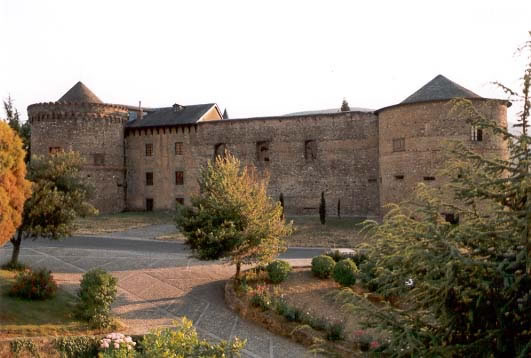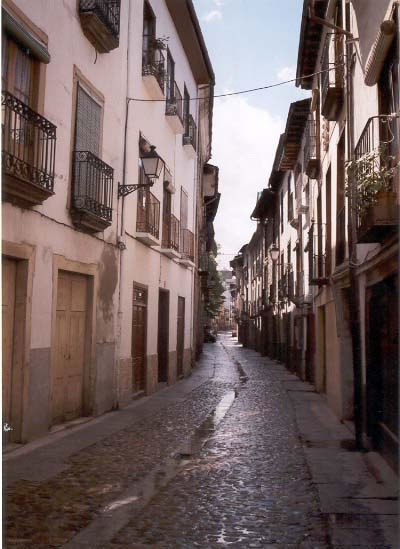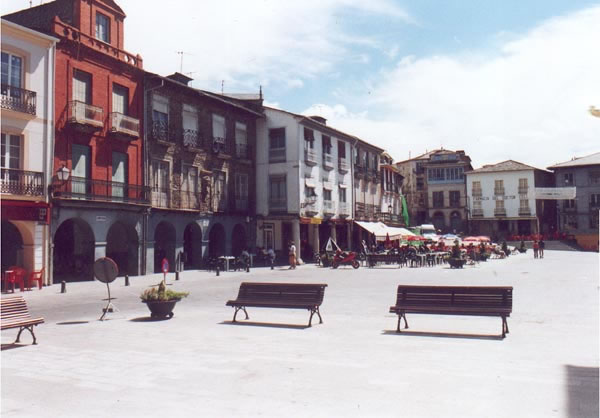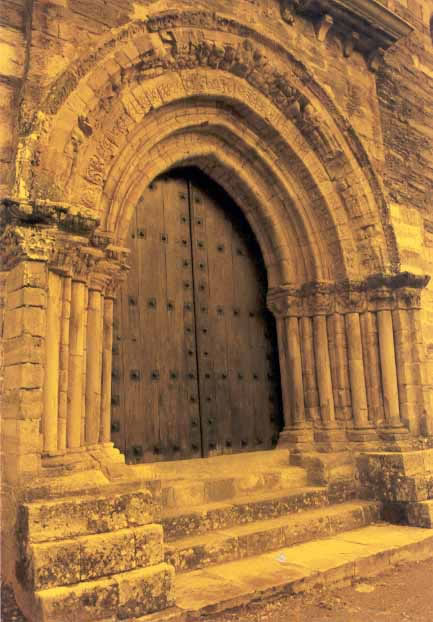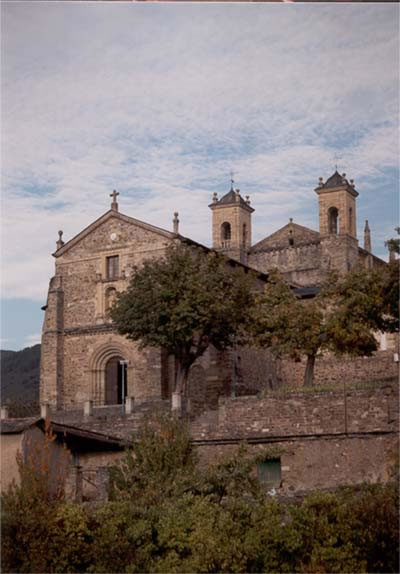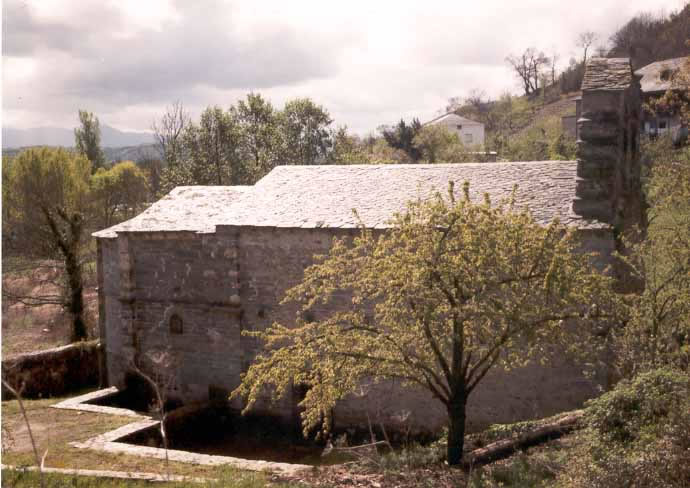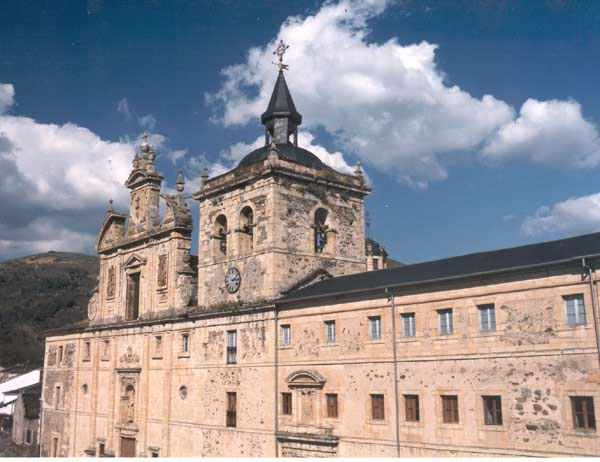VILLAFRANCA DEL BIERZO
12 Km. From La Portela de Valcarce, you will find Villafranca del Bierzo.
Neolithic axes, a bronze spearhead and a supposed Bronze Age idol, preserved in the PP museum. Paulos, are the material witnesses of a population that would already have some importance in pre-Roman and Roman times, in view of the abundant castroic remains and the gold exploitations.
The nearby Castro of the Ventosa, gives us faith of the location of the primitive Celtic city of Bergidum, later transferred to Cacabelos with the name of Bergidum Flavium like capital of the Legal Convent of Astorga. In the area of Villafranca they locate the Roman city of Carcesa. And along the area would run the pre-Roman roads XIX and XX mentioned in the Antonino Itinerary.
The oldest known event in the area dates back to Bermud I the Deacon, in 791, as a place of battle, fought alongside the Burbia, between the Muslims who returned from Galicia and the Christians of the Asturian king, their decimation being decimated. In the fray and yielding the crown to his nephew Alfonso II the Casto.
The beginning of the pilgrimages to Compostela, after the discovery of the body of the Apostle in 813, and the difficulties of crossing the Way, are creating privileged nuclei for pilgrims and Villafranca would be the anteroom of the narrow valley of the Valcarce River, Next to the steps or bridges over the river Burbia, the Valcarce and the brook of the Barboriña, constituting the end of one of the days of pilgrimage to Santiago in the Codex Calixtinus. (Rabanal-Villafranca-Triacastela).
Although the legend relates the origins of Villafranca with the cowboys of Tineo and Luarca who descended to the braves of Valdeprado and Leitariegos and who, wishing for greater valleys, entrusted the search for a white cow that came to settle in Villafranca, The monks of Cluny - the black monks - settled in 1070 under the reign of Alfonso VI, for the attention of the French pilgrims and bringing, among other things, the cultivation of The vine
It is also associated with hospitals for care of pilgrims that arise along the Route; In Villafranca we know the existence of several of them:
- -Hospital de Santiago: next to the colegiata and perhaps linked to the abbey of Cluny, with apothecary since the s. XV so it was one of the best in the area, renovated in the s. XVIII.
- -Leprosería of San Lázaro: from the s. XII and still in use in the XVI, disappeared but it is supposed that near the church of Santiago and source of San Lázaro.
- -Hospital de San Roque: where later the convent of the Announced rose.
- -Hospital de San Juan: quoted in the s. XII "supra pontem" for what would be next to the river in the street of the Water or perhaps in San Fiz.
- -Hospital de la Caridad de Sancti Spiritus: very quoted in documents from XIII to XV but not located, ... perhaps in the plot of the convent of the Conception.
- -"It seems that the Franciscan convent was built on a hospital in the Villa.
Along with the above, a fringe of francs was formed, French pilgrims who would remain in these lands and that would give the name "villa francorum" and importance to the population. No doubt Jews, Galicians and people from other lands would also be established. Also it is spoken of villa without franchises. For several centuries it would have two corregidores, one for the Franks and another for the ones of the place.
The rise of the route inclines to king Alfonso VI to grant a cedula 17 of December of 1072, exempting to the pilgrims of the payment of the portazgo that demanded the castle of Santa Maria de Autares, next to Villafranca, in "offering to the Apostle under whose Power is all Spain ".
The Vico Francorum is also mentioned in a document of 1120 and others are preserved which collect urban transactions (1147) or licenses (from Dona Urraca to Pedro Bruno in 1152 to build an oven).
In 1186, the bishop of Astorga obtained a papal bull to found a church on the ground near Villafranca, which might be Santiago, where the "concheiros" unable to complete the Jacobean route will be able to win the jubilee here.
Before the end of the s. XII, Alfonso VII granted the Señorío, placing in front to its sister Dona Sancha. Dona Urraca, the wife of Ferdinand II, was the king who republished the town and dated it to twenty letters, and with Dona Teresa, wife of Alfonso IX, king who visited the town on nineteen occasions and granted on February 1, 1192 The first Fueros, confirmed in 1230, to Dona Maria de la Cerda (Countess of Medinaceli) until arriving at Pedro Fernandez de Castro, major butler of Alfonso XI and later Count of Benavente, to whom Enrique III confiscated it, to grant it to Don Pedro Enríquez, Count of Trastamara in 1394.
Later, the town would belong to the archbishop of Santiago, Don Pedro de Luna, who was to be sold in 1445 to Don Pedro Alvarez Osorio, married to Dona Beatriz de Castro and daughter of Don Pedro Enríquez, Count of Lemos.
A description of a document from the file of the monastery of Santiago from the end of the s. XV, speaks of "its narrow streets and, because of this layout and its darkness, were committed at night all sorts of crimes. There were many poor people in it and had no property of their own. Their neighbors were peasants selling at the doors of their houses: wine, bread, fish, fruit, oil, straw, barley, rams and kids. So did the gentlemen. "The German servant Brother Hermann Kuning of Bach leaves his memories in passing in 1495, especially as far as wine is concerned.
In 1486, the Catholic Monarchs converted the Señorío into Marquesado in favor of Luis Pimentel and Pacheco - son of the Count of Benavente - and Juana Osorio and Bazán. His daughter and heir Maria, married with Don Pedro Alvarez de Toledo of the house of Alba, who would be Viceroy of Naples and from which, the Marquis began to accumulate nobility titles until becoming Great of the Kingdom with the tenth Marquis (Antonio Maria Alvarez de Toledo and Pérez de Guzmán the Good) title granted by Carlos III or Counts of Peñarramiro from 1871.
Villafranca also passed by the emperor Carlos V when it goes to Santiago to summon the Cortes of 1520, origin of the war of the Communities. Here he received a commission of Castilians who request to celebrate the Cortes in Castile.
In the fourteenth and fifteenth centuries, a nucleus of craftsmen and an incipient guild bourgeoisie was developed that would give rise and splendor to the town and that would increase in successive years, as evidenced by the important buildings (Castle, Collegiate and convents of the Conception, San José, San Nicolás, La Anunciada, Divina Pastora, ...) that are built throughout the XVI and XVII.
The cluniac abbey had entered crisis and at the beginning of the XIV it was in a ruinous state although it remained occupied by the monks until the beginning of the XVI, under the invocation of the Assumption of Our Lady. When arriving the Marquis to Viceroy of Naples in 1529, it takes advantage of its high political situation to obtain the transformation of the cluniacense monastery in colegiata of canons, extending the popes four bulas favoring the erection (1529, 1531 and 1532) and arriving to have mitred abbot, 24 canons dependent of Rome and 60 parishes under its jurisdiction.
Bartolomé de Villalba and Estaña in the book "Pelegrino curioso" of 1577 speaks of 800 neighbors and two Franciscan monasteries (nuns and friars).
Near the Castle was the convent of Dominicas de la Laura, founded at the beginning of the s. XVII by Dona Maria de Toledo, Duchess of Alba, who traveled to Peñalba to bring important relics of San Genadio and his companions, and that he would move to Valladolid within a few years.
The Italian clergyman Domenico Laffi noted in his travel notebook in 1670: "This is a beautiful enclave in a hollow between four towering mountains; In it they converge two great rivers and it is the last town of the kingdom of Leon, although better it would be called city for being very great. It has many convents, both of friars and nuns, a large square and beautiful houses ". This traveler also mentions the legend of the stolen cloak, reminiscent of the attitude of a local innkeeper who stole the cloak from a pilgrim and found him covering the shoulders of the apostle in Compostela, the innkeeper being punished with a fine of ten maravedis By the bishop of Santiago.
In 1715 a great flood flooded the convent of the Announced and many houses, we suppose that in the area of the street of Water, being the lowest part. The year 1589 suffered the scourge of the plague and were many victims.
In the seventeenth and eighteenth centuries it became a prominent commercial, artistic and cultural center. The Marquis appoints for the government of the town and eleven localities of its jurisdiction two ordinary mayors, a corregidor, six regidores and five notaries of number. The economy is based on a large group of artisans (almost 50 percent of the population), which together with livestock and agricultural activity, generates the holding of fairs and crowded markets. The annual fairs of San Antonio and Santiago are celebrated since medieval times.
It was also at this time the religious capital of Bierzo, both by the number of ecclesiastics and by the incomes that the Church received. In the mid-eighteenth century it had 41 clerics, including abbots and canons of the collegiate church and 131 religious: 18 Jesuits, 36 religious in San Francisco, 29 Conceptionists, 26 Clarisses and 22 Augustinian Recollects. As previously noted, the Cabildo of the Collegiate Church of Santa Maria, free from the jurisdiction of Astorga, depended on the Apostolic Chair with table, factory, common bag and all school insignia. From him came illustrious men such as President Muñoz Torrero, the most prominent protagonist of the Cortes of Cadiz and the Constitution of 1812. In the nineteenth would become the parish church of the Assumption.
From 1832, another traveler - Richard Ford - tells us his peculiar vision: "the aspect of Villafranca del Bierzo is completely Swiss. It is located in a mountainous funnel, with bridges, convents, hamlets, salient balconies and vineyards, besides the splendid trucheros rivers that are the Burbia and the Valcarce ". Manier speaks of 534 neighbors and the hospital of Santiago.
For many other travelers (Davillier in 1862, ...) will never pass unnoticed in this city that is classified as mountainous, agricultural, surrounded by vineyards, artisan, mercantile, capital, stage of pilgrimage ... Jovellanos speaks in 1792 of 2500 inhabitants and suitable place For trout fishing.
In June of 1808 emphasized the town for being Headquarters of the Army of Galicia. Looted three times by English fugitives in the War of Independence, it would be ravaged by the French, who also occupied it. They dismantled the castle, stole the Collegiate Church and the Annunciation, profaned the tombs of San Lorenzo de Brindis and the Marquises, burned the municipal archives, ... Here the general who led the Spanish troops against Napoleon, Antonio Filangieri, died in 1808. Liberated definitively to the third time in 1810, it became the center of operations for the conquest of Astorga, to the control of the general Santocildes.
The Journal of La Coruna of July 29, 1808 gives news of the stay in Villafranca of the Literary Battalion, formed by university students. It would be again in 1812. The war paralyzed the planned national factory for the production of rolled steel in San Jose de Paradaseca in La Somoza, approved in 1805, directed by the gunner D. Juan Manuel Munárriz, I would have given the area a try.
If any map of Galicia drawn in s. XVII included the area of Villafranca in its area, on January 27, 1822 became the province of El Bierzo-Valdeorras by decree of the Cortes and in June was constituted the first Provincial Council of the new province, with capital in the Villa and encompassing In addition Toreno, Ponferrada, Bembibre and Boat of Valedoras, fact that only would last ten years because the new administrative division decreed the 30 of November of 1833 would divide its territory between the new provinces of Orense and Leon.
Around 1850, Pascual Madoz described the judicial party of Villafranca with 8 villas, 113 places and 23 villages, which form 21 town halls. Madoz talks about donating goods from neighbor Gabriel de Robles to the Jesuits to teach them how to read and write Latin grammar and rhetoric. In the middle of the nineteenth, Villafranca will have a chair of Latin, public school and four individuals.
On August 14 and 15, 1858, the town would receive the visit of Queen Elizabeth II and the Prince of Asturias, future Alfonso XII, with parades, fireworks, floral arch in the main square and stay in the Palace of the Marquesa Of Campomanes, in the street of the Water.
Jane Leck on her 1883 trip tells us about vineyards, a barracks in the castle, a hotel on the main square and a procession.
The traveler Hans Friedrich Gadow in 1895 speaks of 4000 inhabitants, electric lighting, windmills and irrigation, of the fair of Santiago in front of the Castle, the place of the Constitution, the street of the Water with hospital and fonda, railroad until Villafranca and diligence towards Galicia By the Valley of Valcarce where the smithies abound.
The birthplace of the poet Enrique Gil and Carrasco (1815), his best known work "The Lord of Bembibre" would immortalize for literary facts and Bercian landscapes. Patria also of the essayist Father Martín Sarmiento (Pedro José García Balboa born in 1695 and the son of a master stonemason who worked in the Collegiate Church), the painter Demetrio Monteserín or Antonio Morete, as some tombstones on facades of buildings were inhabited By them.
Until the middle of the century it maintained its hegemony within the Bierzo thanks to its outstanding role in the functional, administrative and demographic. The economic base was centered on handicrafts, local trade, fairs and administrative activities.
At the beginning of the s. XX was the third provincial nucleus in importance and population behind the capital and Astorga, being now relegated by other nuclei, especially Ponferrada, although it is located in the first line of tourist importance, thanks to its beauty and to the passage of the pilgrimages, that in The second half of this century have been reborn with special force throughout Europe.
From 1943 until 1966 he was head of one of the two judicial parties in which the Bierzo was divided, passing later to the one of Ponferrada.
Throughout the second half of the twentieth century, the population of rural areas continues to decline, except in Vilela, and growing in the capital.
The relationship between the towns passes through Villafranca as a service center of the valley and natural exit to the rest of the region.
The tourist activity and the exploitation of the vineyards and orchards are the resources that maintain Villafranca, as well as an incipient industry in the Polygon of Vilela.
The image described by the travelers continues to be beautiful, although it is in danger of disappearing by actions little respectful or uncontrolled growths.





